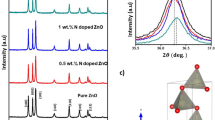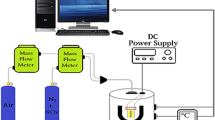Abstract
Zinc oxide (ZnO)-based nanocomposites had been realized for promising photocatalytic and sensing applications. We have obtained multi-walled carbon nanotubes with a gold and ZnO (MWCNT/ZnO/Au) nanocomposite via ultrasonic assistance and studied them for photocatalytic degradation of methylene blue as well as for hydrogen gas sensing. Initially, the structural studies, conducted with x-ray diffraction (XRD) patterns of the specimens, indicated the hexagonal graphite crystal system of the MWCNT and a hexagonal wurtzite structure of ZnO existing in the nanocomposite. Transmission electron microscopy results indicated that the ZnO nanoparticles with an average size of 12 nm and 6-nm-sized gold nanoparticles formed on the surface of micrometer-sized long and 20-nm to 30-nm thick MWCNTs. UV–vis absorbance spectroscopic studies revealed the quantum confinement from the ZnO nanoparticles and plasmonically enhanced absorbance originating from the Au nanoparticles in the nanocomposite. Photoluminescence confirmed the inhibition of electron–hole pair recombination via the composite formation. Photocatalytic methylene blue degradation could achieved 99% efficacy with the MWCNT/ZnO/Au photocatalyst under a white light-emitting diode, and the tricomponent photocatalyst also showed better recyclability. Gas-sensing experiments conducted with the nanocomposite exhibited a low-temperature hydrogen gas sensitivity and showed the highest response at 200°C with excellent selectivity for hydrogen gas sensing.






Similar content being viewed by others
References
C. Dongjie, Y. Cheng, N. Zhou, P. Chen, Y. Wang, K. Li, S. Huo, P. Cheng, P. Peng, R. Zhang, L. Wang, H. Liu, Y. Liu, and R. Ruan, Photocatalytic degradation of organic pollutants using TiO2-based photocatalysts: a review. J. Clean. Prod. 268, 121725 (2020).
J. Lau Yien, N.M. Mubarak, M. Juey Yee, L. Sie Yon, C. Han Bing, M. Khalid, and E.C. Abdullah, An overview of functionalised carbon nanomaterial for organic pollutant removal. J. Ind. Eng. Chem. 67, 175 (2018).
D. Yingjie, N. Zhang, C. Xing, Q. Cui, and Q. Sun, The adsorption, regeneration and engineering applications of biochar for removal organic pollutants: a review. Chemosphere 223, 12 (2019).
G. Nisha, K. Narasimhulu, and Y. Pydi Setty, Recent advances in the bio-remediation of persistent organic pollutants and its effect on environment. J. Clean. Prod. 198, 1602 (2018).
D. Chunhao, Y. Zhou, H. Peng, S. Huang, P. Qin, J. Zhang, Y. Yang, L. Luo, and X. Zhang, Current progress in remediation of chlorinated volatile organic compounds: a review. J. Ind. Eng. Chem. 62, 106 (2018).
Y. Deyou, L. Li, M. Wu, and J.C. Crittenden, Enhanced photocatalytic ozonation of organic pollutants using an iron-based metal-organic framework. Appl. Catal. B 251, 66 (2019).
P. Yunhong, X. Li, Q. Xia, J. Wu, Y. Li, J. Xiao, and Z. Li, Adsorptive and photocatalytic removal of persistent organic pollutants (POPs) in water by metal–organic frameworks (MOFs). J. Chem. Eng. 337, 351 (2018).
N. Meena, T.C. Zhang, and D. KumarZ, Recent progress in g-C3N4, TiO2 and ZnO based photocatalysts for dye degradation: strategies to improve photocatalytic activity. Sci. Total Environ. 767, 144896 (2021).
A. Hassan, A. Mahmood, J. Lee, K. Ki-Hyun, P. Jae-Woo, and A.C.K. Yip, Photocatalysts for degradation of dyes in industrial effluents: opportunities and challenges. Nano Res. 12(5), 955 (2019).
R. Asma, M. Ikram, S. Ali, F. Niaz, M. Khan, Q. Khan, and M. Maqbool, Photocatalytic degradation of dyes using semiconductor photocatalysts to clean industrial water pollution. J. Ind. Eng. Chem. 97, 111 (2021).
S.T. Craig and D.F. Ollis, Photocatalytic degradation of organic water contaminants: mechanisms involving hydroxyl radical attack. J. Catal. 122, 178 (1990).
W.M. Ralph, and S.R. McEvoy, Photocatalytic degradation of phenol in the presence of near-UV illuminated titanium dioxide. J. Photochem. Photobiol. A 64(2), 231 (1992).
F.M. Sher Bahadar Khan, M.M. Rahman, A. Jamal, A.M. Asiri, and M.M. Abdullah, Synthesis, characterizations, photocatalytic and sensing studies of ZnO nanocapsules. Appl. Surf. Sci. 258(2), 672 (2011).
M. Govindaraj, S. Babu, and R. Rathinam, Integrated electrocoagulation–photoelectrocatalytic oxidation for effective treatments of aqueous solution bisphenol-A using green-synthesized ZnO nanoparticles. Chem. Pap. 77, 169 (2023).
S. Banumathi, J. Uma, A. Ravi, B. Balraj, C. Siva, P. Ilanchezhiyan, and G. Mohan Kumar, Rapid sun-light driven photocatalytic functions of 3D rGO/ZnO/Ag heterostructures via improved charge transfer kinetics. J. Mater. Res. Technol. 10, 1301 (2021).
H. Ting-Jen and H. Cheng-Liang, Fabrication of gas sensing devices with ZnO nanostructure by the low-temperature oxidation of zinc particles. Sens. Actuators B Chem. 131(2), 572 (2008).
B. Garam, I.S. Jeon, M. Jang, W. Song, S. Myung, J. Lim, S.S. Lee, J. Ha-Kyun, P. Chong-Yun, and A. Ki-Seok, Complementary dual-channel gas sensor devices based on a role-allocated ZnO/graphene hybrid heterostructure. ACS Appl. Mater. Interfaces 11(18), 16830 (2019).
P.J. Cao, Q.G. Huang, S.T. Navale, M. Fang, X.K. Liu, Y.X. Zeng, W.J. Liu, F.J. Stadler, and Y.M. Lu, Integration of mesoporous ZnO and Au@ ZnO nanospheres into sensing device for the ultrasensitive CH3COCH3 detection down to ppb levels. Appl. Surf. Sci. 518, 146223 (2020).
C.P. Singh, and S. Bhattacharya, Hydrogen gas sensing methods, materials, and approach to achieve parts per billion level detection: a review. Int. J. Hydrogen Energy. 44(47), 26076 (2019).
S. Garg, V. Mishra, L.F. Vega, R. Shyam Sharma, and L.F. Dumée, Hydrogen biosensing: prospects, parallels, and challenges. Ind. Eng. Chem. Res. 62(11), 4676 (2023).
C. Kyo-Sang and C. Sung-Pil, Effect of structure morphologies on hydrogen gas sensing by ZnO nanotubes. Mater. Lett. 230, 48 (2018).
J. Haocheng, W. Zeng, and Y. LiZ, Gas sensing mechanisms of metal oxide semiconductors: a focus review. Nanoscale 11(47), 22664 (2019).
R. Qiang, C. Yan-Qiang, D. Arulraj, C. Liu, D. Wu, L. Wei-Ming, and L. Ai-Dong, Resistive-type hydrogen sensors based on zinc oxide nanostructures. J. Electrochem. Soc. 167(6), 067528 (2020).
R. Florian, V. Postica, F. Schütt, Y.K. Mishra, A.S. Nia, M.R. Lohe, X. Feng, R. Adelung, and O. Lupan, Highly selective and ultra-low power consumption metal oxide based hydrogen gas sensor employing graphene oxide as molecular sieve. Sens. Actuators B Chem. 320, 128363 (2020).
C. Siva, A. Vijay, G. Mohan Kumar, M. Alagiri, J. Thiruvadigal, and M. Rathinam, Three-dimensional (3D) flower-like nanoarchitectures of ZnO-Au on MWCNTs for visible light photocatalytic applications. Appl. Surf. Sci. 449, 631 (2018).
H. Farzaneh, A. Kasaeian, F. Pourfayaz, M. Sheikhpour, and D. Wen, Novel ZnO-Ag/MWCNT nanocomposite for the photocatalytic degradation of phenol. Mater. Sci. Semicond. Process. 83, 175 (2018).
H.K. Muna, H.T. Hussein, and A.M. Abdul Hussein, Study of the effect of CNTs, and (CNTs-ZnO) on the porous silicon as sensor for acetone gas detection. Optik 259, 168825 (2022).
T. Dana, A. Popa, M. Stan, M. Stefan, G. Vlad, S. Ulinici, and G. Baisan, Visible-light-driven photocatalytic degradation of different organic pollutants using Cu doped ZnO-MWCNT nanocomposites. J. Alloys Compd. 866, 159010 (2021).
M.K.A. Mustafa, Carbon nanotubes loaded ZnO/Ag ternary nanohybrid with improved visible light photocatalytic activity and stability. Optik 217, 164867 (2020).
Q.A. Drmosh, A.H. Hendi, M.K. Hossain, Z.H. Yamani, R.A. Moqbel, A. Hezam, and M.A. Gondal, UV-activated gold decorated rGO/ZnO heterostructured nanocomposite sensor for efficient room temperature H2 detection. Sens. Actuators B Chem. 290, 666 (2019).
Author information
Authors and Affiliations
Corresponding author
Ethics declarations
Conflict of interest
On behalf of all authors, the corresponding author states that there is no conflict of interest.
Additional information
Publisher's Note
Springer Nature remains neutral with regard to jurisdictional claims in published maps and institutional affiliations.
Rights and permissions
Springer Nature or its licensor (e.g. a society or other partner) holds exclusive rights to this article under a publishing agreement with the author(s) or other rightsholder(s); author self-archiving of the accepted manuscript version of this article is solely governed by the terms of such publishing agreement and applicable law.
About this article
Cite this article
Arul, P., Vivek, C., Balraj, B. et al. Optoelectronic and Hydrogen Gas-Sensing Applications of Ultrasonically Fabricated ZnO-Au Nanoparticle-Decorated MWCNTs. J. Electron. Mater. 52, 5264–5271 (2023). https://doi.org/10.1007/s11664-023-10495-7
Received:
Accepted:
Published:
Issue Date:
DOI: https://doi.org/10.1007/s11664-023-10495-7




